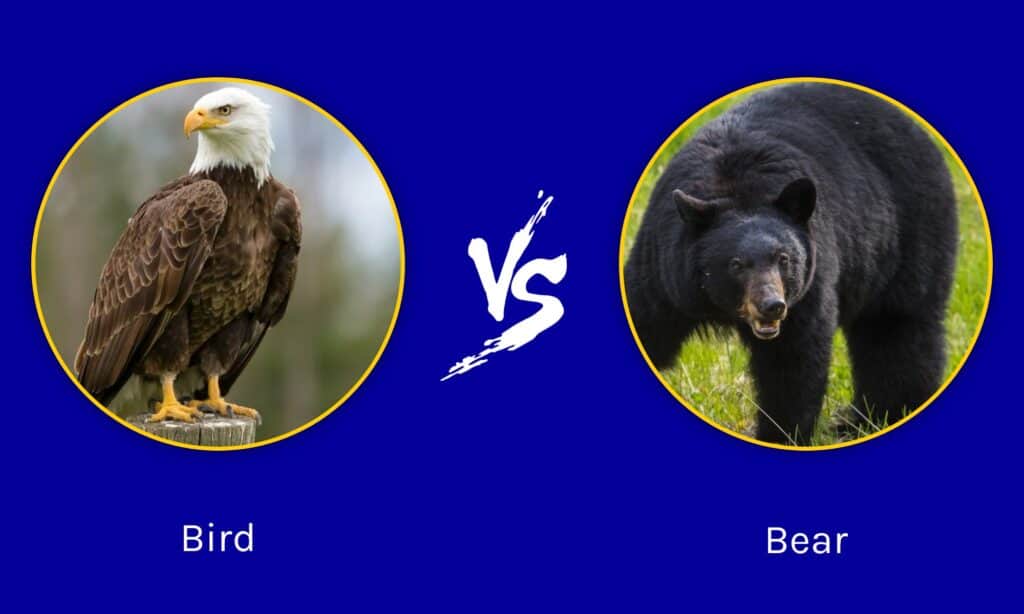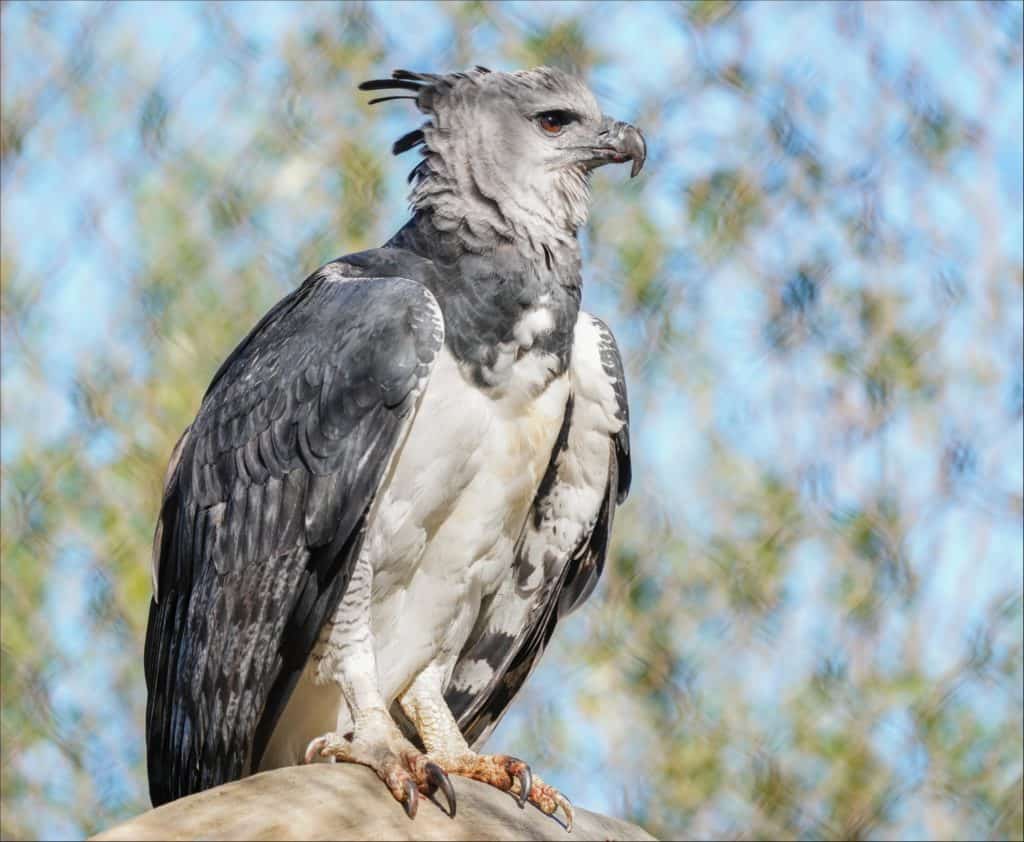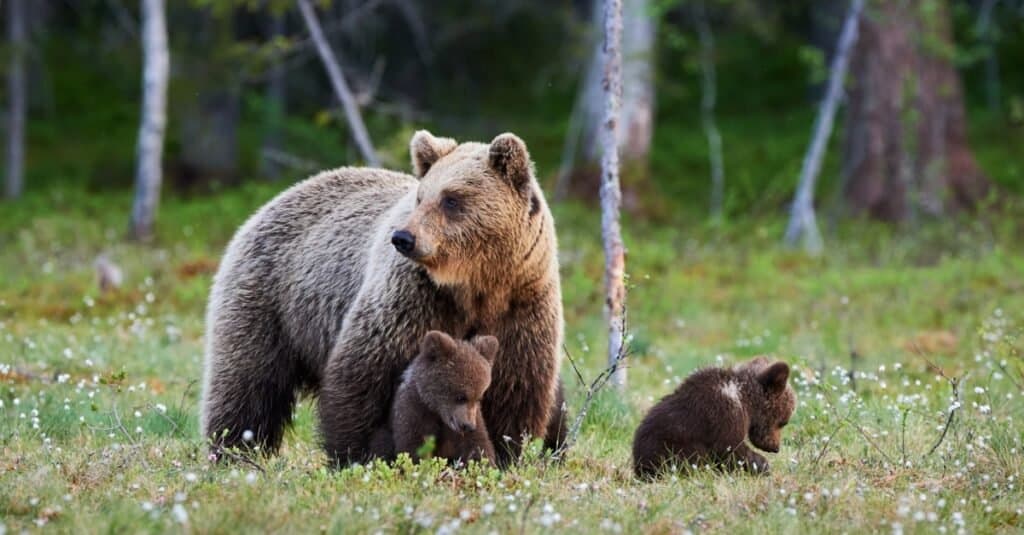A claw is a curved pointed keratin nail on each digit of a mammal’s, reptile’s, or bird’s foot. It is mostly a hardened modified epidermis created for scratching, gripping, digging, and climbing. Some birds, such as eagles, have a long curved talon for gripping prey, whereas domesticated birds, such as chickens, only have short, strong claws for scraping the soil for food.
On the other hand, bears have incredibly skillful paws and claws for climbing, swiping, digging, and ripping apart prey. Who has the biggest claws between bears vs birds? This comprehensive article will reveal fascinating facts about birds and bear claws.
Comparing a Bear and a Bird

| Bear | Bird | |
|---|---|---|
| Weight and size | 60 to 990 pounds in weight and 4 ft to 11 ft in height. | 0.004 to 286 pounds in weight and 2 to 106 inches in height. |
| Location | Mostly found in North America, South America, Asia, and Europe. | Can survive in many habitats worldwide, from the lowest deserts to the highest mountains. |
| Speed | Between 20 to 35 mph | Between 20 to 242mph |
| Strength | 1200 PSI (Grizzly bear) | Between 200 to 500 PSI |
| Attack style | Attacks its prey with a strike from its forepaw. | Uses its sharp talons to capture food or its claws to perch on branches while they eat seeds, insects, or fruits. |
| Claw size | Between 2 to 5inches | Between 1.17 inches to 5 inches |
Similarities Between a Bird and a Bear
Despite birds and bears many differences, these creatures also have a lot in common. Here are some of the features they share:
Birds and Bears are Vertebrates
Bears and birds are categorized as vertebrates because they have backbones and skeletal systems. The skeleton of birds are lightweights, made of mostly thin and hollow bones, which aids their stability during flight. The bear’s spinal cord, on the other hand, is incorporated in tough cartilage or bone that allows them walk with the majority of their body weight.
Birds and Bears are Endothermic
Warm-blooded birds and mammals, like bears, are known for maintaining a consistent body temperature without relying on an external heat source. These creatures shiver to create heat when cold through rapid muscle contraction, whereas cold-blooded animals, such as lizards, regulate their body temperature by changing their environment. Interestingly, for birds and bears, their warm-blooded similarity births other common features such as their calorie requirements and the capacity for them to stay active in cooler temperatures. Moreover, they can live on any landmass on Earth.
Bears and Birds Take Care Of their Young
Birds and bears both care for their offspring once they are hatched or born. However, the nurturing time varies by animal species and the age at which the young are competent to care for themselves. Female mammals feed their young milk from their breasts, while female aves feed their chicks beak to beak.
Bears vs. Birds: Who Has The Biggest Claws?

Having a talon length of 4.8 inches, the harpy eagle’s claws are longer than any bear’s claws.
©TIKO IGITYAN/Shutterstock.com
The harpy eagle has the biggest claws of all birds in the world. The size of this bird of prey’s talons are longer than any bear’s claws.
When determining which animal has the biggest claws, one has to keep in mind that these lovely creatures come in various sizes and species, and these factors determine how big or small their claws are. The grizzly bear’s claws, for example, range between 2-4 inches, and it surprisingly uses these sharp claws for digging roots and ground squirrels and for excavating dens.
On the other hand, the harpy eagle takes the lead while possessing the longest talons among all birds. Surprisingly, the typical male talon length is 3.4 inches, and the female talon length is 4.8 inches. Other predatory birds, such as hawks and owls, have noticeable talons, which are used to catch and dissect prey.
Bears vs. Birds: Claw Uses

Bears use their claws for digging and as weapons for fighting.
©iStock.com/LuCaAr
How a bird uses its talons depends on its individual needs and foot strength; nevertheless, the most typical uses include preening, gripping, and itching at parasites in the feathers. On the other hand, bears use their claws for digging, climbing, or as weapons when fighting.
What Are The Key Differences Between A Bird And A Bear?
Bears differ from birds in many ways. Despite certain similarities, birds and mammals (bears) have significant distinct characteristics.
Feathers and Furs
While birds have a variety of feathers covering their bodies that aid their flight, insulate their bodies to keep them warm, and also keep them cool during hot seasons, a bear is endowed with furs which also provide extra insulation during long winter slumber.
Beaks and Teeth
Birds do not have teeth, but they have beaks that are specifically suited for their diets. These beaks come in different shapes for different bird species and help them preen, manipulate objects, probe for food, kill prey, fight, and feed their young. Carnivorous birds like eagles, hawks, and owls effortlessly use their sharp, hooked beaks for ripping and tearing.
Seed-eating birds like sparrows, weavers, and finches use their strong, cone-shaped beaks to break through shells, while seabirds like ducks and geese have broad, flat beaks for straining food out of the water. On the contrary, bears use their teeth for tearing, ripping, chewing, and grinding their meals.
Egg-laying and Live-bearing
Although some mammals such as the platypus and spiny anteaters lay eggs, their eggs cannot be compared to a bird’s egg, made mostly of calcium and a layer of hardened mucus. Bears, on the other hand, give birth to live young.
Wings and Legs
Surprisingly, the wings are not only confined to birds, as some flying mammals and insects have wings that they use for their daily activities. Moreover, not all birds with wings can fly, but their different wing shapes provide distinct advantages peculiar to each species. For example, the narrow, sharp-tipped wings of the falcon provide speed for this bird species. The elliptical wings of crows and ravens allow fast take-offs and tight maneuvering. The long and narrow active soaring wings of albatrosses and gulls allow them to soar high without flapping their wings. Swimming birds, such as penguins and puffins, use their flipper-shaped wings to move through the water rapidly, while bears use their legs for running, walking, and standing.
The photo featured at the top of this post is © Chepe Nicoli/Shutterstock.com
Thank you for reading! Have some feedback for us? Contact the AZ Animals editorial team.







